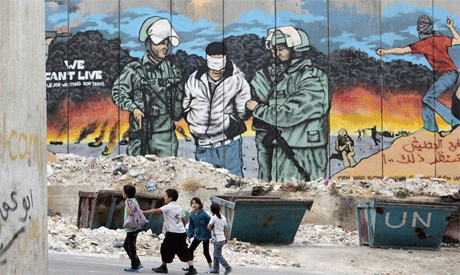
Children walk in front of a mural painted on part of the separation wall at Aida refugee camp in the West Bank town of Bethlehem, 2012 (Photo: Reuters)
Everywhere you turn, walls in the Gaza Strip are covered with paint -- brightly coloured slogans, political portraits and prose.
For youth in the besieged enclave packed with 1.8 million people, graffiti is an important tool for self-expression and fighting back.
Since their birth, they have never known anything beyond this tiny strip of land wedged between Egypt and Israel, with the Mediterranean Sea to their backs.
In the south, the walls rail against Egypt's closure of the Rafah border crossing.
In the north, they condemn the Israeli soldiers who prevent them from crossing through Erez.
There is that pervading sense of being trapped, of powerlessness in the face of Israeli bombardments, the never-ending progression of funerals, the humiliation and the oppression.
All these things find expression in the gaudy slogans daubed on walls and in alleyways across the territory.
"In painting these walls, I feel free," says Naim Samsum, a bearded 25-year-old wearing a black beanie hat, white jeans and a Superman T-shirt.
"What we want is to send a message to say that people here love life, that they have had enough of death and destruction," says Samsum, who draws his inspiration from online videos of graffiti "tags" on the side of train cars in Europe. A tag is a graffiti artist's signature.
As with many other art forms in Gaza, politics is never far off.

Palestinian boys walk past a mural painting at Dehaishe refugee camp in the West Bank town of Bethlehem, 2012 (Photo: Reuters)
On one wall are giant portraits of some of the best-known Palestinians.
There is one depicting iconic Yasser Arafat, who founded the Fatah movement and died in mysterious circumstances in 2004. Next to him is a likeness of Sheikh Ahmed Yassin, founder of the rival Hamas movement, who was assassinated by Israel the same year.
Since 1987, when the first Palestinian uprising began, Gaza's walls have been covered with political messages, calls to strike and details of upcoming demonstrations. Back then, militants would even use the walls to chronicle the dates of Israeli air strikes and the names of the victims, or "martyrs."
Using spray paint as a political tool is not new in Gaza, says Fayez al-Sarsawi, who both paint and sculpts.
"Graffiti is a form of art which doesn't cost much and lets you reach people easily," he says.
And Basel al-Maqusi, who runs an art gallery in an upscale area of Gaza City, says it is also a relatively safe way of getting your message across.
"Writing on the wall is the simplest way to reach people, without putting yourself in too much danger. Handing out pamphlets requires a lot of time and could cost you your life, while writing something on a wall stays for a long time and it can be seen by everyone."
Unlike the earliest, hastily scrawled graffiti, vibrant frescoes that catch the attention of admiring passersby are now created by young people.
In front of a bombed-out police station that was hit during the summer war, a wall is covered with a picture of a child with his fist raised, under which is written "Freedom."
For Musab Abu Daff, freedom is the very essence of graffiti.
"I learned to do graffiti because it's a form of freedom. It allows you to express yourself, talk about where you live, especially here in Gaza where everything is destroyed," says this 20-year-old street artist in baggy jeans and a Bob Marley T-shirt.
"We need to express our feelings."
"The Israelis oppress us, they stop us from travelling and they have besieged Gaza. So I decided to write on the walls of Gaza exactly what is happening to us," he says.

A Palestinian girl walks past graffiti on a wall in the West Bank village of Aboud, 2009 (Photo: Reuters)
Short link: